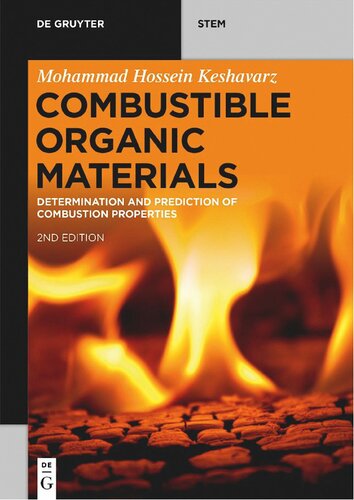

Most ebook files are in PDF format, so you can easily read them using various software such as Foxit Reader or directly on the Google Chrome browser.
Some ebook files are released by publishers in other formats such as .awz, .mobi, .epub, .fb2, etc. You may need to install specific software to read these formats on mobile/PC, such as Calibre.
Please read the tutorial at this link. https://ebooknice.com/page/post?id=faq
We offer FREE conversion to the popular formats you request; however, this may take some time. Therefore, right after payment, please email us, and we will try to provide the service as quickly as possible.
For some exceptional file formats or broken links (if any), please refrain from opening any disputes. Instead, email us first, and we will try to assist within a maximum of 6 hours.
EbookNice Team

Status:
Available0.0
0 reviews
ISBN 10: 3110782049
ISBN 13: 9783110782042
Author: Keshavarz M H
The combustion properties of organic materials are used to assess their safety specifications. This knowledge is necessary to avoid potentially disastrous fires. The experimental determination of the combustion properties of a new organic compound is laborious and sometimes even impossible. This book describes methods for the determination and prediction of the combustion properties of organic compounds, along with some examples and exercises. This 2nd Edition includes an updated and improved presentation of the applicationnof different new models for reliable prediction of diverse aspects of flammability of organic compounds.
1 Flash Point
1.1 Measurement of the FP
1.2 Predictive methods of the FP for pure compounds
1.2.1 Empirical models
1.2.2 The SGC methods
1.2.2.3 The improved SGC approaches based on experimental data of a wide range of organic compounds
1.2.3 QSPR models
1.2.3.8 Organosilicon compounds
1.3 Estimation methods of the FP for mixtures
1.3.1 Mixing rules
1.3.2 Assessment of combination of the mixing rule of Liaw et al. [82] and QSPR models
1.3.3 Empirical methods for liquid mixtures
1.3.3.1 Catoire et al. method [100]
1.3.3.1.1 Determination of NBPmix
1.3.3.1.2 Determination of ΔvapH∘(298.15 K) mix
1.3.3.1.3 Determination of nC,mix
1.3.3.2 Pan et al. method [120]
1.3.3.2.1 MLR model
1.3.3.2.2 MNR model
1.3.3.2.3 Comparison of two models of Pan et al. [120] and Catoire et al. [100]
1.4 Summary
2 Autoignition
2.1 Measurement of the AIT
2.2 Predictive methods of the AIT for pure compounds
2.2.1 The use of SGC by a polynomial of degree 3 for organic compounds
2.2.2 A simple QSPR model for various classes of hydrocarbons
2.2.3 A new and reliable model for prediction of the AIT of organic compounds containing energetic groups
2.2.4 Simple method to assess the AIT of organic ether compounds with high reliability
2.2.5 Reliable prediction of autoignition temperature of organic hydroxyl compounds
2.3 Autoignition and ignition delay
2.4 Summary
3 Flammability Limit
3.1 Measurement of the LFL and UFL
3.2 Predictive methods of the flammability limits
3.2.1 The predicted LFL as a function of temperature
3.2.2 The use of SGC method for prediction of the LFL and UFL of pure hydrocarbons
3.2.3 Extended method for prediction of the UFL of pure compounds
3.2.4 Machine learning-developed models for prediction of LFL and UFL
3.3 Flammability limit estimation of the hydrocarbon‐inert gas mixture
3.4 Summary
4 Heat of Combustion
4.1 Experimental methods for determination of heats of combustion
4.2 Different approaches for prediction of the heats of combustion
4.2.1 Predicting the standard net heat of combustion for pure hydrocarbons from their molecular structure
4.2.2 Prediction of the standard net heat of combustion from molecular structure
4.2.3 A comprehensive methodology for prediction of the net heat of combustion from group contribution-based property models
4.2.4 A generally applicable group additivity method for the calculation of the gross heat of combustion of organic compounds as well as salts and ionic liquids
4.2.5 Machine learning-developed models of prediction of the net heat of combustion of organic compounds
4.2.6 Reliable predictions of the net heat of combustion of organosilicon compounds
4.2.7 A new method for predicting the gross heat of combustion of polynitro arene, polynitro heteroarene, acyclic and cyclic nitramine, nitrate ester and nitroaliphatic compounds
4.3 Summary
5 Polymer Flammability
5.1 Experimental method based on pyrolysis combustion flow calorimetry
5.2 Different approaches for prediction of flammability parameters
5.2.1 SGC method of Walters and Lyon for prediction of the heat release capacity
5.2.2 SGC method of Lyon et al. for prediction of total heat release (heat of combustion), char yield, and heat release capacity
5.2.3 The simplest model for reliable prediction of total heat release (heat of combustion)
5.2.4 A simple model for reliable prediction of the specific heat release capacity of polymers
5.2.5 A simple method for the reliable prediction of char yield of polymers
organic combustibles
combustible organic materials
combustible organic material
organic compounds are combustible
a combustible liquid is any liquid having a
organic combustible material
Tags: Keshavarz M H, Combustible, Organic